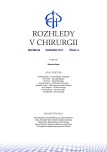Chest injuries in polytraumatized children
Authors:
M. Rygl 1; T. Pešl 2; D. Hechtová 3; M. Prchlík 2; B. Frýbová 1; J. Trachta 1; M. Kynčl 4
Authors‘ workplace:
Klinika dětské chirurgie 2. LF Univerzity Karlovy a FN v Motole, Praha
přednosta: prof. MUDr. M. Rygl, Ph. D.
1; Klinika dětské chirurgie a traumatologie 3. LF Univerzity Karlovy, Thomayerova nemocnice, Praha
přednosta: prof. MUDr. P. Havránek, CSc.
2; Klinika anesteziologie, resuscitační a intenzivní medicíny 2. LF Univerzity Karlovy a FN v Motole, Praha
přednosta: MUDr. T. Vymazal, Ph. D., MHA
3; Klinika zobrazovacích metod. 2. LF Univerzity Karlovy a FN v Motole, Praha
přednosta: prof. MUDr. M. Roček, CSc.
4
Published in:
Rozhl. Chir., 2017, roč. 96, č. 12, s. 498-503.
Category:
Review
Overview
Chest injuries in children are part of polytrauma resulting from high-energy violence, most often caused by traffic accidents. Blunt chest injuries (95%) are significantly more frequent than penetrating injuries (5%). Lung contusion, rib fracture, pneumothorax or haemothorax, are the more common injuries, but tracheobronchial rupture, cardiac or diaphragmatic injuries may also occur. The anterior X-ray image remains the basic examination method for isolated chest injuries. CT trauma scan with a contrast medium is done in polytraumatized children. Blunt injuries of intra-thoracic organs in haemodynamically stable children are treated mostly conservatively (85%) under full monitoring at the ICU. Surgical treatment is necessary in a minority of patients. Mortality and morbidity of patients with chest injury depend on the actual combination of multiple body systems injury. The severity of total injury can be predicted using objective scoring systems (Abbreviated Injury Scale=AIS; Injury Severity Score=ISS). Overall mortality ranges from 6 to 20%. Mortality is high but this is mainly due to associated head injuries.
Key words:
multiple trauma − thoracic trauma – paediatric − lung contusion − Injury Severity Score=ISS
Sources
1. Pearson EG, Fitzgerald CA, Santore MT. Pediatric thoracic trauma: Current trends. Semin Pediatr Surg 2017;26:36−42.
2. Tovar JA, Vazquez JJ. Management of chest trauma in children. Paediatr Respir Rev 2013;14:86−91.
3. Tran A, Campbell BT. The art and science of pediatric damage control. Semin Pediatr Surg 2017;26:21−6.
4. Vyhnanek F. [Importance of interdisciplinary cooperation in multiple trauma management] Czech, Rozhl Chir 2014;93:282−6.
5. Vodicka J, Dolezal J, Vejvodova, S, et al. [Chest injury and its surgical treatment in polytrauma patients. Five-year experience.] Czech, Acta Chir Orthop Traumatol Cech 2016;83:123−6.
6. Okur MH, Uygun I, Arslan MS, et al. Traumatic diaphragmatic rupture in children. J Pediatr Surg 2014;49:420−3.
7. Pandit V, Michailidou M, Rhee P, et al. The use of whole body computed tomography scans in pediatric trauma patients: Are there differences among adults and pediatric centers? J Pediatr Surg 2016;51:649−53.
8. Goedeke J, Boehm R, Dietz HG. Multiply trauma in children: Pulmonary contusion does not necessarily lead to a worsening of the treatment success. Eur J Pediatr Surg 2014;24:508−13.
9. Pearson EG, Clifton MS. The role of minimally invasive surgery in pediatric trauma. Surg Clin North Am 2017;97:75−84.
10. Wood JW, Thornton B, Brown CS, et al. Traumatic tracheal injury in children: a case series supporting conservative management. Int J Pediatr Otorhinolaryngol 2015;79:716−20.
11. Dominguez E, De La Torre C, Sanchez AV, et al. Severe tracheobronchial injuries: our experience. Eur J Pediatr Surg 2015;25:71−6.
12. Ramos CT, Babyn PS, Koplewitz BZ, et al. What have we learned about traumatic diaphragmatic hernias in children? J Pediatr Surg 2000;35:601−4.
13. Rating the severity of tissue damage. I. The abbreviated scale. JAMA 1971;215:277−80.
14. Baker SP, O‘Neill B, Haddon W Jr, et al. The injury severity score: a method for describing patients with multiple injuries and evaluating emergency care. J Trauma 1974;14:187−96.
15. Mayer T, Matlak M E, Johnson DG, et al. The modified injury severity scale in pediatric multiple trauma patients. J Pediatr Surg 1980;15:719−26.
16. Doud AN, Weaver AA, Talton JW, et al. Mortality risk in pediatric motor vehicle crash occupants: Accounting for developmental stage and challenging abbreviated injury scale metrics. Traffic Inj Prev 2015;16,Suppl 2:S201−8.
Labels
Surgery Orthopaedics Trauma surgeryArticle was published in
Perspectives in Surgery

2017 Issue 12
Most read in this issue
- Pulmonary contusion
- Ruptures of the diaphragm
- Myxoid liposarcoma localised in the peritoneal cavity − case report
- Chest injuries in polytraumatized children
